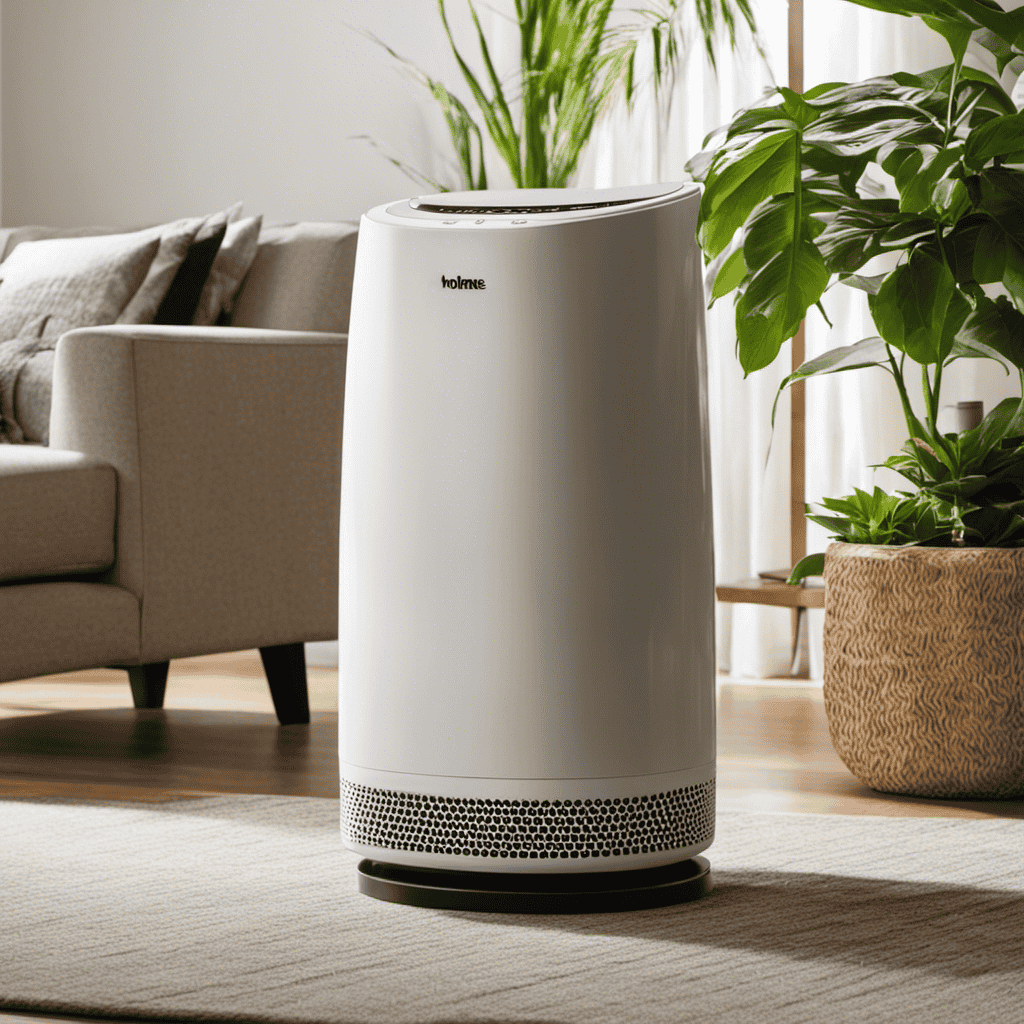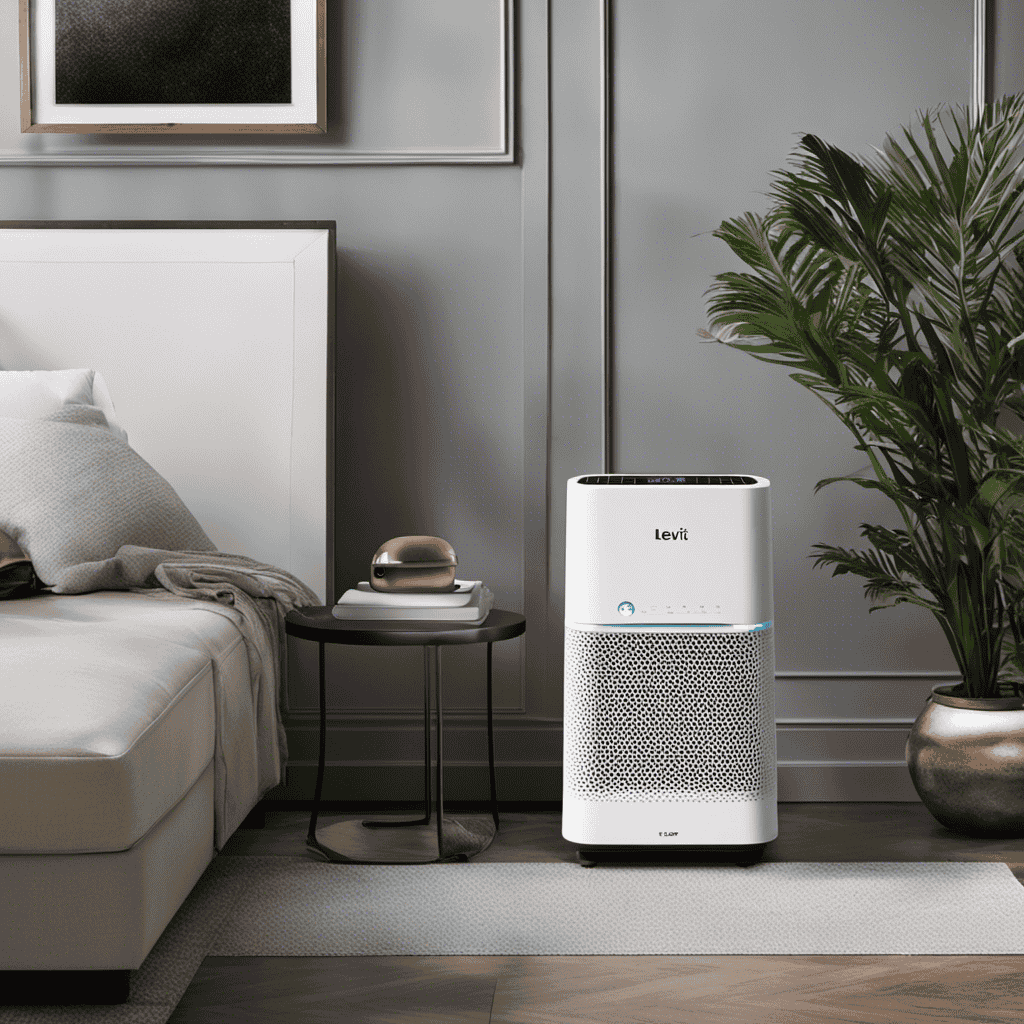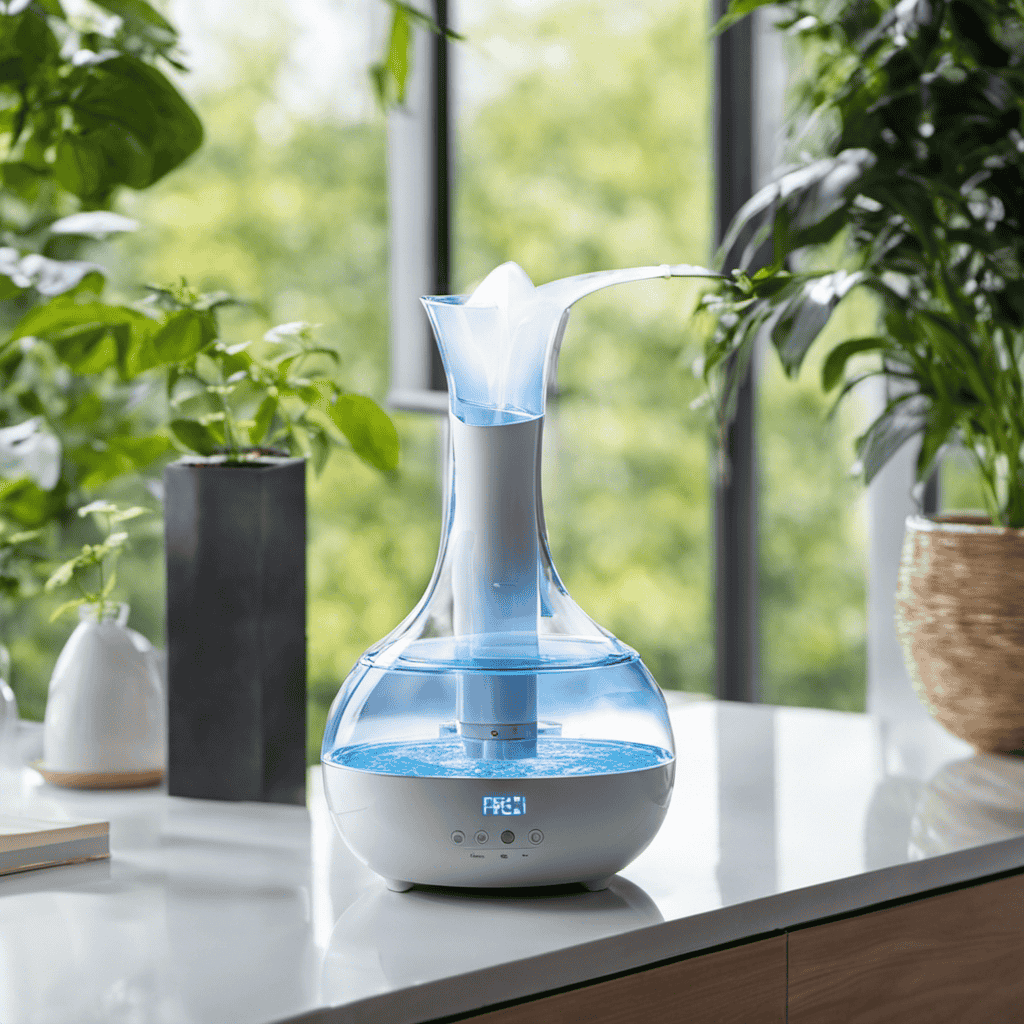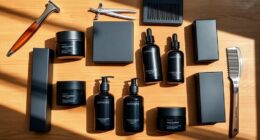Congratulations on your smart choice of purchasing an air purifier! However, before you place it just anywhere in your house, there are certain locations you should absolutely steer clear of.
Trust me, I’ve learned from experience. In this article, I’ll be sharing some valuable insights on where you should NOT put an air purifier.
From the bathroom to areas with high humidity, I’ll cover it all to ensure you get the most out of your purifier.
Let’s dive in!
Key Takeaways
- Do not place an air purifier in the bathroom due to high humidity that can damage the device and lead to mold and mildew growth.
- Avoid placing the air purifier near the kitchen stove as it can pose a fire hazard, damage internal components, and overload the filters with smoke and odors from cooking.
- Do not place the air purifier directly in front of windows or doors as it restricts airflow and hinders the purifier’s effectiveness by blocking natural ventilation.
- Avoid placing the air purifier beside or underneath furniture as it obstructs airflow, reduces purification effectiveness, and may pose safety hazards such as overheating or blocked power cord access.
In the Bathroom
You shouldn’t put an air purifier in the bathroom because the high humidity can damage the device. Although it may seem like a logical place to have one, the bathroom’s constant moisture can create potential health risks and moisture damage to the air purifier.
The primary purpose of an air purifier is to filter and clean the air, removing pollutants and allergens. However, in a humid environment like the bathroom, the excess moisture can cause mold and mildew to grow inside the purifier. Mold spores can then be released into the air, leading to respiratory issues and allergies. Additionally, the moisture can also corrode the internal components of the device, reducing its efficiency and lifespan.
Therefore, it is advisable to place the air purifier in a more suitable location outside the bathroom to ensure its proper functioning and longevity.
Near the Kitchen Stove
Placing an air purifier near the kitchen stove may pose a fire hazard. The high temperatures and moisture from the stove can damage the internal components of the purifier, potentially causing malfunctions or fires. Additionally, the smoke and odors from cooking can overload the purifier’s filters, reducing its effectiveness. Therefore, it is important to consider the potential health risks and maintenance considerations when deciding where to place an air purifier. Regular maintenance, such as cleaning or replacing filters, is essential for optimal performance. It is advisable to place the air purifier away from the kitchen stove to minimize the risk of fire and ensure proper maintenance.
Directly in Front of Windows or Doors
When it comes to placing an air purifier in your home, it’s important to consider the location carefully. One area to avoid is directly in front of windows or doors. This may seem like a convenient spot, but it can actually have negative effects on the performance of your air purifier.
Placing it in front of windows or doors restricts airflow, reduces effectiveness, blocks natural ventilation, and hinders circulation, ultimately limiting its ability to clean the air efficiently.
Restricts Airflow, Reduces Effectiveness
Restricting airflow can significantly reduce the effectiveness of an air purifier. Placing an air purifier in a location where it is restricted from receiving proper airflow can hinder its ability to effectively clean the air. Air purifiers work by drawing in air, filtering out pollutants, and then releasing clean air back into the room. If the airflow is restricted, the air purifier will not be able to effectively circulate the air and capture harmful particles. This can result in reduced purification efficiency and less clean air in the room.
Therefore, it is important to ensure that the air purifier is placed in a location where it can receive proper airflow to maximize its effectiveness.
Blocks Natural Ventilation, Hinders Circulation
To maximize the effectiveness of your air purifier, ensure that it is not blocking natural ventilation, as this can hinder circulation. Proper air purifier placement is crucial for optimal performance.
Placing the unit near windows or doors that allow fresh air to enter the room is ideal. This ensures a continuous flow of air, allowing the purifier to effectively filter out pollutants and allergens.
Additionally, avoid placing the air purifier in corners or behind furniture, as this can restrict airflow and limit its ability to circulate clean air throughout the entire room. By allowing the purifier to have access to natural ventilation, you can ensure that it operates at its best and provides you with fresh, clean air.
Now, let’s discuss the importance of avoiding placing the air purifier beside or underneath furniture.
Beside or Underneath Furniture
When it comes to placing an air purifier, it’s important to avoid placing it beside or underneath furniture. This is because doing so can pose various risks.
Firstly, there is a risk of airflow obstruction, as the furniture can block the intake and output vents of the purifier, hindering its ability to effectively circulate and purify the air in the room.
Secondly, placing the purifier in such a position can also result in reduced purification effectiveness, as the furniture may act as a barrier, preventing the purifier from reaching and cleaning the entire space.
Lastly, there are potential safety hazards to consider, such as the purifier overheating or the furniture blocking access to the power cord, which could lead to accidents or damage.
Airflow Obstruction Risks
Make sure you don’t place an air purifier in a position that blocks the airflow. Proper placement is crucial for the optimal performance of your air purifier. Here are three risks of obstructing airflow:
-
Reduced effectiveness: Placing the air purifier in a position that obstructs the airflow can significantly reduce its effectiveness. This is because the air purifier needs a clear path to draw in and filter the air, trapping pollutants and improving air quality.
-
Increased strain on the unit: When the airflow is blocked, the air purifier has to work harder to circulate the air, leading to increased strain on the unit. This can result in faster wear and tear, reducing the lifespan of the purifier.
-
Overheating: Blocking the airflow can cause the air purifier to overheat. This can not only damage the internal components but also pose a safety risk in extreme cases.
To ensure effective air purifier maintenance and to choose the right air purifier for your needs, always follow the manufacturer’s guidelines for proper placement and avoid obstructing the airflow.
Reduced Purification Effectiveness
In the previous section, we discussed the risks of obstructing the airflow of an air purifier. Now, let’s explore how improper placement can lead to reduced purification effectiveness.
When an air purifier is placed in areas with limited airflow, such as behind furniture or in closed cabinets, it hinders its ability to effectively circulate and filter the air. This can result in reduced energy consumption and compromised air quality.
To ensure optimal performance, it is crucial to place the air purifier in an open area with good air circulation. Additionally, regular maintenance is essential to keep the air purifier functioning at its best. This includes cleaning or replacing filters, emptying the collection tray, and keeping the unit free from dust and debris.
By following these guidelines, you can maximize the purification effectiveness of your air purifier and enjoy cleaner air in your living space.
Now, let’s move on to the next section where we will discuss potential safety hazards associated with air purifiers.
Potential Safety Hazards
To ensure safe operation, it’s important to regularly inspect and clean the filters and components of your air purifier. Neglecting maintenance requirements can lead to potential health risks and safety hazards.
Here are three key areas to focus on when maintaining your air purifier:
-
Filters: The filters in your air purifier play a crucial role in capturing and removing airborne pollutants. Over time, these filters can become clogged with dust, allergens, and other particles, reducing their effectiveness. Regularly cleaning or replacing the filters is essential for maintaining optimal air quality.
-
Fan and Motor: The fan and motor of your air purifier work together to circulate air and keep it clean. Regularly inspecting and cleaning these components can prevent dust buildup and ensure proper functioning. It’s important to follow the manufacturer’s instructions for cleaning and lubricating the fan and motor.
-
Exterior Surfaces: Cleaning the exterior surfaces of your air purifier is not only important for aesthetic reasons but also for maintaining a healthy environment. Dust and dirt can accumulate on the outside of the purifier, potentially leading to poor air quality. Wiping down the surfaces with a soft cloth or using a mild cleaning solution can help keep your air purifier clean and free from potential health risks.
In Areas With High Humidity
Avoid putting an air purifier in areas with high humidity, as it can cause damage to the device. High levels of moisture in the air can lead to the accumulation of water inside the purifier, leading to malfunction or even electrical hazards. Basements and laundry rooms are two common areas that tend to have higher humidity levels. In basements, the lack of proper ventilation and the presence of dampness can create a breeding ground for mold and mildew, which can affect the performance of an air purifier. Similarly, laundry rooms often have high humidity due to the use of washing machines and dryers. The constant exposure to moisture can cause the air purifier to deteriorate quickly and potentially pose a safety risk. Therefore, it is best to place air purifiers in areas with lower humidity levels for optimal performance and longevity.
| Areas with High Humidity |
|---|
| Basements |
| Laundry Rooms |
Close to Electronics or Appliances
If you place an air purifier close to electronics or appliances, it can interfere with their functionality. Here are three reasons why you should avoid placing an air purifier near these devices:
-
Blocked Airflow: When an air purifier is placed too close to electronics or appliances, it can block the airflow necessary for the proper functioning of these devices. This can lead to overheating and potential damage over time.
-
Reduced Efficiency: Electronics and appliances rely on proper ventilation to maintain their efficiency. Placing an air purifier nearby can hinder the airflow, causing these devices to work harder and consume more energy, leading to reduced efficiency.
-
Compromised Performance: Air purifiers generate air circulation, which can disturb the performance of sensitive electronics. The movement of air, dust particles, or electromagnetic interference from the purifier can disrupt the functioning of devices like computers, televisions, and sound systems.
In a Confined Space
Placing an air purifier in a confined space can restrict its effectiveness and limit the circulation of clean air. While air purifiers are designed to remove pollutants and improve air quality, they need adequate space to function optimally. Confined spaces, such as small rooms or closets, can hinder the airflow and decrease the purifier’s ability to effectively clean the air. To illustrate the limitations of using an air purifier in a confined space, let’s consider the following table:
| Confined Space Limitations | Benefits of Air Purifiers in Larger Areas |
|---|---|
| Restricted airflow | Improved air quality |
| Limited coverage area | Reduction of allergens and pollutants |
| Inefficient purification | Removal of odors and harmful particles |
| Lowered effectiveness | Enhanced respiratory health |
| Reduced air circulation | Minimized risk of respiratory illnesses |
As shown in the table, placing an air purifier in a larger area provides numerous benefits, including improved air quality, reduction of allergens and pollutants, removal of odors, and enhanced respiratory health. Therefore, it is advisable to use air purifiers in larger areas to fully maximize their effectiveness and enjoy the full range of benefits they offer.
Frequently Asked Questions
Can I Place an Air Purifier in My Bedroom or Living Room?
I wouldn’t put an air purifier in the kitchen or bathroom. These areas tend to have high levels of moisture and odors, which can damage the purifier’s filters and reduce its effectiveness.
Is It Safe to Put an Air Purifier in a Basement or Garage?
Putting an air purifier in a basement or garage may seem like a good idea, but it’s actually not safe. These areas often have high humidity levels and pollutants that can damage the purifier and compromise its effectiveness.
What Are the Potential Risks of Placing an Air Purifier Near a Fireplace or Wood-Burning Stove?
Placing an air purifier near a fireplace or wood-burning stove can pose potential risks. Precautions must be taken to ensure safety, such as keeping a distance from open flames and regularly cleaning the purifier’s filters to prevent buildup.
Can an Air Purifier Be Placed in a Nursery or Children’s Room?
In a nursery or children’s room, an air purifier can help improve indoor air quality and create a healthier environment. However, it’s important to consider factors like noise level and maintenance requirements.
Is It Recommended to Use an Air Purifier in a Home Office or Study Area?
Using an air purifier in a home office or study area has many benefits. It can help remove allergens, dust, and odors, creating a cleaner and healthier environment. When choosing one, consider room size and filtration needs.
Conclusion
In conclusion, it’s crucial to be mindful of where you place your air purifier for optimal performance.
Avoid placing it in the bathroom or near the kitchen stove, as moisture and cooking fumes can damage the purifier.
Likewise, placing it directly in front of windows or doors can disrupt airflow.
It’s also important to keep it away from furniture, high humidity areas, and electronics or appliances.
Remember, finding the right spot for your air purifier is like finding a needle in a haystack – it can make all the difference in improving the air quality in your home.










